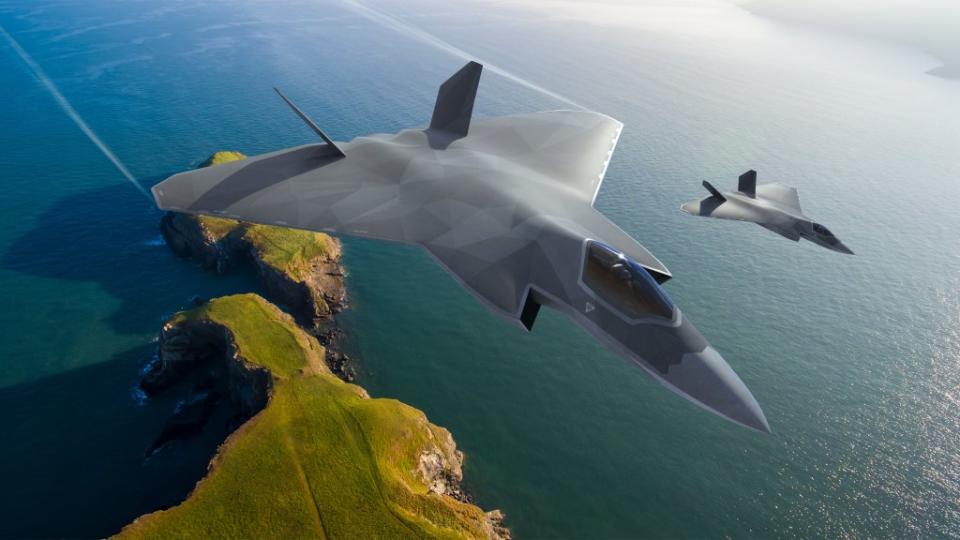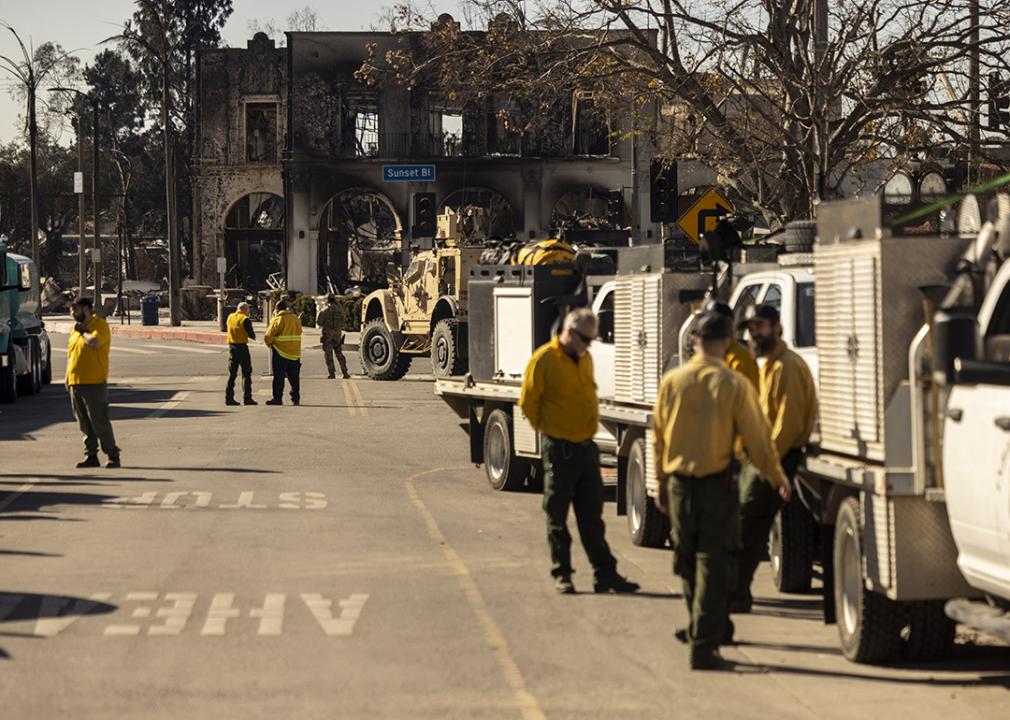More details have emerged about the United Kingdom’s Tempest next-generation stealth fighter, being developed under the Global Combat Air Program (GCAP). While many specifics of the aircraft are still being decided by the three partner nations — the United Kingdom, Japan, and Italy — we now know there are plans to arm it with larger air-to-air missiles offering a longer range than those currently used by these countries.
Published today, the House of Commons committee report on GCAP provides recommendations to the U.K. government. Of particular interest is the section outlining the capabilities of the Tempest, with the proviso that “the precise capabilities of the new aircraft remain to be determined.”

A rendering of a pair of Tempests overflying the U.K. coastline. BAE Systems
Nevertheless, Richard Berthon, Director Future Combat Air at the U.K. Ministry of Defense, told the committee that the three partner nations have reached an agreement on overall system requirements. Berthon further noted that a “mismatch” around requirements “tends to be the thing that undermines international partnerships as they play out.”
As to the key requirements for the Tempest, which will drive the design of the new aircraft, the Chief of the Air Staff Air Chief Marshal Sir Richard Knighton laid these out to the committee.
Some of them are to be expected, including longer range, which is reflected in the large overall size of the fighter, at least in the concept artworks, models, and mockups that have appeared so far.

The latest concept configuration for the Tempest reveals a design tailored for long-range performance combined with a significant payload capacity. Leonardo Leonardo
Knighton also says that the Tempest will feature “improved stealth,” without providing more details about how that will be achieved, and also notes the central importance of data fusion. Indeed, fusing and integrating “the vast amount of information that will be available” to the aircraft will be the main difference between the Tempest and previous generations of combat aircraft, the report contends.
Intriguingly, Knighton also said it was “absolutely” possible that an uncrewed version of the Tempest platform could be developed in the longer term.

The Chief of the Air Staff, Sir Richard Knighton. Crown Copyright
As to the larger and longer-range air-to-air missile, this will be carried as part of a bigger payload than offered by current combat aircraft.
In the past, statements about the U.K.’s Future Combat Air System (FCAS) program, a wide-ranging U.K. air combat initiative that includes the Tempest, have referenced next-generation weapons — as well as uncrewed platforms, networks and data sharing, and more. However, very few if any details have been provided about these weapons, making the reference to a large long-range air-to-air missile all the more interesting.
Currently, the longest-range air-to-air missile available to the United Kingdom and Italy is the pan-European MBDA Meteor, which arms the Eurofighter Typhoon and will be integrated on the F-35.

A U.K. Royal Air Force Typhoon takes off, loaded with Meteor missiles below the fuselage. Crown Copyright
The ramjet-powered Meteor was designed to have superior range and overall kinematic performance than the U.S.-made AIM-120 AMRAAM, which also arms the Typhoon and F-35.
Range claims for the Meteor differ widely and the actual figure is a closely guarded secret. However, the missile is generally assumed to be able to hit targets up to 130 miles away from the launch aircraft. In comparison, the AMRAAM, in its longer-range D-model form, is commonly assessed to have a range of around 100 miles. In practice, an air-to-air missile’s range is highly dependent on a wide number of factors, including the track of the target and the height and speed of the launch platform.

An F-22 Raptor fires an AIM-120 AMRAAM missile. U.S. Air Force www.twz.com
For its part, Japan currently also uses the AMRAAM, as well as the domestically developed Mitsubishi AAM-4, another medium-range air-to-air missile. This is reported to have a range of around 75 miles and, in its AAM-4B version, became the first air-to-air missile to feature an active electronically scanned array (AESA) seeker. It is carried by Japanese F-15J and Mitsubishi F-2 fighters but is too large to be accommodated internally in the F-35, which Japan also operates.

Japan Air Self-Defense Force AAM-4B air-to-air missile test round. Hunini/Wikimedia Commons
The Meteor, AMRAAM, and AAM-4 all utilize active radar homing, providing a ‘fire and forget’ capability, but midcourse updates are required to squeeze the most out of the missile and make long-range engagements reliable.
The three nations in the GCAP program are far from the only ones pursuing programs for new long-range air-to-air weapons.
In recent months, the U.S. Navy has introduced, at least on a limited level, an air-launched version of the Standard Missile-6 (SM-6) under the AIM-174B designation. The range of this missile is classified but should be far in excess of that of the AIM-120D, probably at least double and perhaps even triple the range, against large targets. Meanwhile, a joint U.S. Navy and U.S. Air Force program is jointly developing the AIM-260, a new air-to-air missile that is intended to offer far greater range than the current AMRAAMs, as well as other new and improved capabilities, but will importantly provide these in a missile with similar dimensions to the AIM-120.

A U.S. Navy F/A-18F and F-35 fly over the Point Mugu Sea Range in Southern California with a U.S. Air Force F-15 during Gray Flag 2024 in September 2024. The F/A-18F carries four of the recently introduced AIM-174B missiles. U.S. Navy photo by Lt. Cmdr. Kory Hughs Lt.Cmdr. Kory Hughs
The West’s development of these missiles, and others, has been driven to a large extent by the appearance of very long-range air-to-air weapons in Russia and China.
According to data from the manufacturer, the Russian R-37M, at least in its export form, can defeat “some types” of aerial targets at a range of up to 124 miles. This likely refers to only larger, less agile, aircraft targets and is very much a ‘sales brochure figure,’ with all the caveats that entails. Nevertheless, the missile has proven to be a significant threat in the war in Ukraine.

A Su-35S launches an R-37M missile. Russian Ministry of Defense screencap
Meanwhile, the U.S. Air Force has publicly said that the emergence of the Chinese PL-15, a long-range air-to-air missile that may feature a dual-pulse rocket motor, was a key factor in the decision to start the AIM-260 program. The Royal United Services Institute (RUSI) defense and security think tank determines that the PL-15 “out-ranges the U.S.-made AIM-120C/D AMRAAM series and has a comparable maximum range to the Meteor.”

A folding-fin compressed carriage version of the PL-15, known as the PL-15E, in front of a mockup of the J-35A stealth fighter. Getty Images Photo by Costfoto/NurPhoto via Getty Images
The PL-15 is already in widespread service, and China is also working on further-reaching weapons, including the much bigger PL-17, a very long-range missile that may well be intended primarily to target high-value assets, like tankers and airborne early warning aircraft. You can read more about this still-mysterious missile here.

This 2016 image provided our first look at the PL-17. Chinese Internet
TWZ recently reported on how the U.S. Air Force expects that, by 2050, there will be counter-air missiles that can hit aircraft at ranges as great as 1,000 miles — a huge advance in anti-access capabilities compared to the distances air defense missiles can reach today. Nevertheless, the prediction very clearly shows the direction of travel in this area of warfare.
One option to provide the Tempest with a larger longer-range air-to-air missile would be to acquire one from the United States, although the specific reference to the weapon being larger than existing ones would seem to rule out the AIM-260. On the other hand, other very long-range air-to-air missile programs are known to have been in the works in the United States.
There are different ways of increasing the range of an air-to-air missile, but this process is always easier if the weapon can be made larger. Bigger dimensions can translate to a bigger engine, more fuel, multi-stage rocket motors, and air-breathing engines, like the ramjet used in the Meteor. Other range-extending options that the United States has examined include throttleable “multi-pulse solid rocket motors” and more exotic “propellants, grain configurations, cases, and liners,” all of which would also be able to ensure greater range — as well as higher speed — compared to existing weapons.
It should also be noted that, in the not-too-distant past, the United Kingdom and Japan were involved in a joint effort to develop a possible new-generation air-to-air missile.
This bilateral cooperation saw the U.K. Ministry of Defense support Japan’s Joint New Air-to-Air Missile program, or JNAAM. Still highly secretive, the program is understood to have yielded a missile with a Japanese ‘front end’ in the form of an advanced radio-frequency seeker and a British ‘back end,’ retaining the original Meteor’s ramjet motor.

An infographic for the JNAAM program provides a loose visual indication of how it would have combined Japanese and British components in a single missile. Japan Ministry of Defense
Douglas Barrie, the Senior Fellow for Military Aerospace at the International Institute for Strategic Studies (IISS) think-tank told TWZ that he believes that JNAAM was “successful as far as it went,” but that the program didn’t move beyond technical exploration.
Barrie suggests that the JNAAM may have been discontinued on performance grounds, assessing that it was likely to have a top speed of below Mach 4, and more likely in the region of Mach 3.5, slower than the Meteor, which is thought to fly in excess of Mach 4.
In the meantime, the United Kingdom continued to work on a mid-life update for the Meteor, and this option remains under consideration. Nevertheless, a revamped Meteor might still not meet the performance requirements of the missile envisaged for Tempest, and it would also seem to be ruled out since it’s not understood to be larger than the current Meteor.

As for the Meteor, while this is likely “good enough” to meet the current threats, there is a much bigger question about whether it will be able to match the overall performance of the projected threat by the late 2030s and early 2040s, by which time the Tempest should be established in service.
By this time, the Meteor design will be around 40 years old and new Chinese missiles will challenge Western fighters in the Pacific. Looking beyond Meteor, comments from U.K. defense officials “seem to indicate that they need something new” to arm the Tempest, “in terms of overall performance to meet the projected threat,” Barrie says.
Putting aside the PL-17, which Barrie assesses is optimized for a “very specific value set,” today’s PL-15 is already a very potent weapon and one that is “better by some margin than anything Russia has right now.”

Four dummy PL-15 missiles in the internal weapons bay of a Chinese J-20 fighter. Chinese Internet
It’s likely to be joined before long by a missile currently dubbed PL-16, the design of which seems to have been driven by the requirement for the Chinese J-20 stealth fighter to accommodate six longer-range missiles internally (as opposed to the four PL-15s currently carried). The PL-16 will likely look fairly similar to the PL-15 but will be a compressed-carriage missile. Barrie expects that it will also feature “an active electronically scanned front end, Mach 5-plus fly-out, a lot of very capable onboard software, and be very resistant to jamming.”
Even more alarming for the West is the potential for the carriage of larger numbers of even bigger air-to-air missiles in the capacious weapons bay of the new Chinese combat aircraft that appeared last month, and which has been tentatively dubbed J-36. As we pointed out when it debuted, the large size of this aircraft suggests an overarching concern with long endurance and comparatively massive internal volume to accommodate a very large fuel load, as well as plentiful (large) weapons.

This photo of the J-36 shows to advantage the large internal weapons bay below the fuselage. Chinese Internet
At the same time, there remain questions about the viability of the GCAP and Tempest programs.
A concept demonstrator for the Tempest is planned to fly in 2027, with Richard Berthon telling the Committee that this won’t be a prototype but instead “a reasonably good representation of some of the characteristics that will play through into the GCAP platform itself.”
Thereafter, the Tempest is expected to be in service by 2035, but there will be plenty more challenges, both technical and political. Even if it survives potential political hurdles, the process of creating an all-new fighter, especially one incorporating stealth technologies, dictates lengthy development times and high costs. The Tempest is also planned to be supported by advanced uncrewed aircraft, not to mention new-generation air-launched weapons, all of which bring their own elements of risk — and yet more costs.
Increasingly, the requirements for internal weapons carriage are a very major driver behind the size of the platform, when it comes to next-generation fighters. This appears to be the case for the J-36 and almost certainly applies to the crewed combat jet at the center of the U.S. Air Force’s Next Generation Air Dominance (NGAD) initiative. The Tempest, too, looks like it will be a notably big fighter, and it will almost certainly need to be, not least to accommodate the larger and longer-range air-to-air missiles that are being earmarked for it.
Contact the author: thomas@thewarzone.com
#Emphasizes #Arm #Tempest #Stealth #Fighter #Larger #Longer #Range #AirToAir #Missiles









Leave a Reply